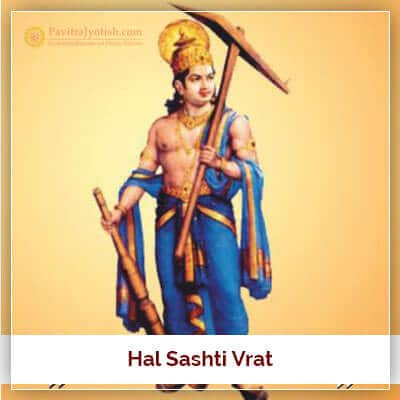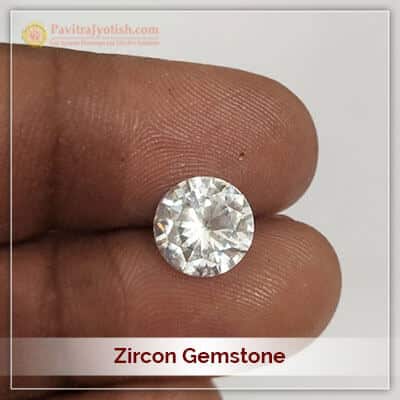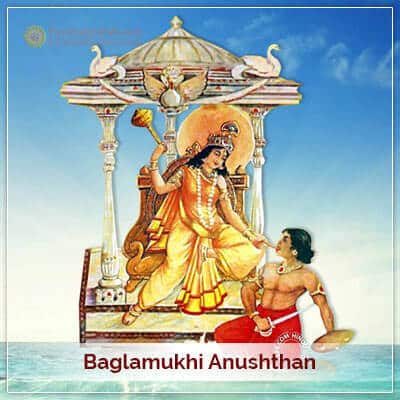Hal Shashti Vrat
Published On : July 4, 2022 | Author : Astrologer Pt Umesh Chandra Pant 
Hal Shashti Or Har Chhath Vrat
Hal Shashthi vrat is all about attaining motherly happiness and fostering children. It is also known by different names and as per the colloquial differences, such as Lalhi Chhath, Tin Chhath, Kamar or Khamar etc. Bestirred by these names, mothers observe this vrat and pray to deity Hal Shashthi about longevity of their children. Such is the wish they ask for the deity that their children could become blessed with long life, full of virtues and civility so as to become successful in their lives. This vrat is observed every year on Shashthi tithi of Krishna Paksha during Bhadrapada month. This vrat is also called Har Chhath in local language. It also symbolizes the importance of farmers’ plow as a tool for cultivation. And this vrat is also celebrated as a birthday of lord Balram who carries plow as a weapon. It also marks celebration of Haldhar, an elder brother of lord Krishna. Female devotees observing this vrat do not eat grains produced by ploughing up the fields. To say otherwise, this vrat is solely dedicated to the women blessed with children. Plants of Kusha, Palash, and Jhadberi are chosen for Har Chhath puja. A single or three separate branches of these plants are dug into a clean earth, which is then sanctified by cleaning with buffalo’s dung. For a spot without soil, these branches are dug into a clean earthenware. Thereafter, numerous ingredients essential for puja are collected and devotee worship Mata Hal Shashthi using Dhupa, Dip etc. Somewhere, the puja is being conducted by priests. Materials like products made from milk and curd are prohibited, except the milk of a buffalo and ghee. One can also use Mahua in diet. Besides these things, rice of Fansahi is also allowed
Puja Methods For Hal Shashti Vrat
Hal Shashthi vrat involves stanch maintenance of sanctity and self-purification by devotees. Prohibited things for devotees in the puja are crops produced by farming. Tiny bits of clay and sugar are used to fill up with wheat, barley, gram, lentils, millet, jwar, Ramdana, Mahua, etc. And the exterior sides of Kundhva (earthen pots) made by potters are painted with lime. The number of these pots are determined based on the number of sons. They are finally kept in order on a big plate made up by brass etc. The deity of Hal Shashthi is offered clothes, one of the fabrics is colored with turmeric and is offered to the deity. Thereafter, devotees wash up the deity Hal Shashthi, offer her fineries of good luck, worship her with Dhupa and Diya. Some books are also worshipped on this occasion as a symbolic reverence to Mata Saraswati. Toys of children are kept near the statue of the deity. Thereafter, devotees offer the plate filled with necessary ingredients of puja to the deity. Some ingredients are left with the deity. Cucumbers are valued greatly and are included in the puja. devotees worship deity Hal Shashthi with great devotions, by including necessary materials, as per popular customs. Certain beliefs somewhere suggest that devotees fill up a trench with water, forming it like a pond and then plant the saplings of Palash, Kusha, and Jhadberi around its bank to continue the worship. They wind around deity Hal Shashthi a raw thread, worship the deity by following all rituals. On this occasion, lord Haldhar or Balram and his weapon, plow, are also worshipped.
Story Of Hal Shashti Vrat
Some stories about this vrat are narrated as follows – Once a milkmaid, who sold milk from village to village regularly, suffered with extreme pain of pregnancy. She thought of her inability to sell milk and curd due to the pain. Agitated by that thought, she gave birth to a child by shielding herself against palash, kusha and jhadberi saplings at the bank of a pond. She reached her home unscathed. She expressed her gratitude to Shashthi Mata. Since then, she observed the puja of Shashthi Mata using palash, kusha, and jhadberi, on every year in Shashthi tithi of Krishna Paksha during Bhadrapada month.
Read More Articles: Skanda Shashti Vrat and About Goddess Saraswati

























